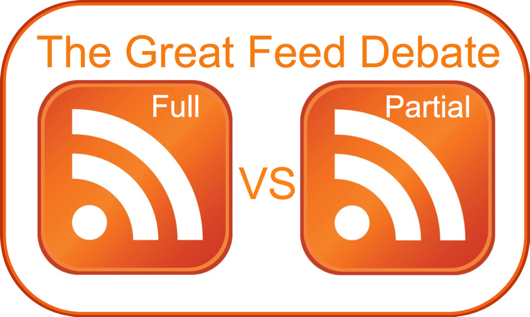This week I want to try something a little different and attempt a debate here at ProBlogger. The idea is simple - I’ve chosen two people who I think have experience around a debated blogging topic to argue the case for either side of it. These two opinions will act as the first speaker for each side and then I (as the moderator) will hand it over to you the ProBlogger readership to act as the 2nd and 3rd speakers for each side.
The idea isn’t to have a bun fight over the topic but to flesh it out and engage in some good conversation and learning.

The Topic
The topic for this debate is ‘Full or Partial RSS Feeds?’ - it’s a topic I get asked about a lot and which I know there are good arguments for on both sides.
The Speakers
 I’ve chosen two speakers for this debate that I think will get a good conversation going. They are:
I’ve chosen two speakers for this debate that I think will get a good conversation going. They are:
Arguing for Partial Feeds is Gina Trapani - editor of the famous Lifehacker blog.
Arguing for Full Feeds is Rick Klau - former VP, Publisher Services at FeedBurner and currently in Strategic Partner Development at Google.
I should say before we start that I put Gina in a position of having to argue for something that she isn’t convinced of herself. She generously agree to participate however.
So without further ado - here’s some thoughts from Gina and Rick to get our discussion going. Feel free to chime in with your thoughts in comments below - no matter what they might be.
The Argument for Partial Feeds
 Gina Trapani - editor at Lifehacker
Gina Trapani - editor at Lifehacker
At Lifehacker.com we offer a choice of either a full-post feed (with ads) or partial feeds (no ads.) While giving the reader a choice is a good thing (at the expense of adding an extra step to the subscription process), I can see why a publisher or a reader might prefer less-popular partial feeds.
As a publisher, providing a pull quote in your feed instead of the full post gives you the advantage of seeing which stories your readers are interested enough to click on. A lot of people assume that publishers use partial feeds just for extra on-page ad views, and that may be true in some cases. But back when I published a personal site - and advertisement-free site - I used partial feeds for editorial purposes. The necessary clicks from feed items served as instant reader feedback. You simply can’t do the kind of traffic tracking with full feeds than you can do with partial ones.
As a reader, I prefer partial feeds in some cases, especially from news sources who can summarize the point of the article in one sentence. Skimming CNET’s partial post feed, which just includes the story lead, is a lot easier and more efficient than including the entire article.
The Argument for Full Feeds
 Rick Klau - former VP, Publisher Services at FeedBurner and currently in Strategic Partner Development at Google.
Rick Klau - former VP, Publisher Services at FeedBurner and currently in Strategic Partner Development at Google.
More than half a million publishers have burned nearly 900,000 feeds over at www.feedburner.com , so it should come as no surprise how often we are asked which is better: full-text or partial feeds? While there is no single, “right” answer that covers all situations, there are a number of often overlooked angles to consider.
First, I’d like to clear up a few points of confusion. Clickthroughs alone are an imperfect (if not altogether inaccurate) measure of a reader’s interest in a story. Partial feeds often make it harder, not easier, for a reader to know whether they’re interested in a story at all. If you just include a sentence or two of a post in a feed, you’re asking the reader to click through to read the rest of the post - when the actual substance of the post is not at all obvious from those first few sentences.
Regarding Gina’s statement that “you simply can’t do the kind of traffic tracking with full feeds that you can do with partial ones” - I respectfully disagree. Publishers who use FeedBurner’s feed management services can measure both feed item views ( i.e., posts which are read in the aggregator) as well as clickthroughs - giving them an accurate view of both clickthroughs, and more importantly, the clickthrough rate. This is true for both full feeds and partial feeds… and is often the best way to measure how engaged your audience is with your content. It should be noted that in feeds who’ve compared full and partial feeds, we’ve seen no hard evidence suggesting that partial feeds alone increase the clickthrough rate.
Now for some reasons why full feeds are in a publisher’s (and a reader’s) best interest. I think Mike Masnick at TechDirt hit the nail on the head earlier this week when he posted about this question:
[F]ull text feeds actually … lead to more page views… Full text feeds makes the reading process much easier. It means it’s that much more likely that someone reads the full piece and actually understands what’s being said — which makes it much, much, much more likely that they’ll then forward it on to someone else, or blog about it themselves, or post it to Digg or Reddit or Slashdot or Fark or any other such thing — and that generates more traffic and interest and page views from new readers, who we hope subscribe to the RSS feed and become regular readers as well. The whole idea is that by making it easier and easier for anyone to read and fully grasp our content, the more likely they are to spread it via word of mouth, and that tends to lead to much greater adoption than by limiting what we give to our readers and begging them to come to our site if they want to read more than a sentence or two.
As I wrote earlier this year on our corporate blog, full posts also contain far richer information within the posts - hyperlinks - that can be exploited by services like TechMeme, Technorati, and other RSS-aware services. Those links are valuable indicators of the relationships between posts - which can yield tremendous context for readers who want to discover related content. Partial posts rob readers (and automated services) of that context, as the hyperlinks themselves aren’t included in the partial posts.
Commercial publishers who distribute feeds often worry about the lack of revenue - they make money on their site and are understandably concerned that they are “giving away” their content through the feed. But it’s possible to monetize your feed directly (through FeedBurner’s feed and blog ad network, among other options) - and if you buy Masnick’s argument above, traffic to your site will actually increase thanks to the fuller feed (which means your site revenue will increase as well!).
Readers clearly prefer full feeds over partial feeds; one need only see the outcry from Freakonomics readers (read the comments) last week when they switched from a full feed to a partial feed to understand that readers value the delivery of information in its entirety, to an environment (their newsreader) they prefer. Certainly there are occasions when a partial feed is required: many commercial publishers have licensing issues that prevent them from including full text in the feed, and in those cases, some content’s better than no content. But when it’s better for the readers (who get what they want, where they want it), better for the publishers (who can drive more revenue and satisfy their users), and better for the ecosystem (which get more information, which allows them to add more value to their users), it’s my opinion that full feeds are simply better.
Have Your Say
OK - Rick and Gina have kicked the conversation off - it’s time to have your say!
Do you use Full Feeds, Partial Feeds - or both? Why?

Ajánlott bejegyzések:
A bejegyzés trackback címe:
Kommentek:
A hozzászólások a vonatkozó jogszabályok értelmében felhasználói tartalomnak minősülnek, értük a szolgáltatás technikai üzemeltetője semmilyen felelősséget nem vállal, azokat nem ellenőrzi. Kifogás esetén forduljon a blog szerkesztőjéhez. Részletek a Felhasználási feltételekben és az adatvédelmi tájékoztatóban.